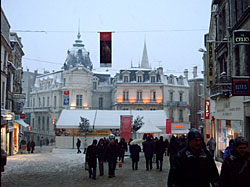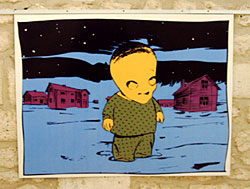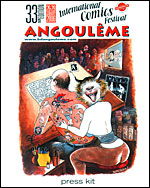>> The Once and Future Angoulême
>> Angoulême: Adventures In Comics' Capital City
More...

Spring is in the air, and by the time this hits the web, it may well be summer where you are. For me, it's time to figure out where I'm going to be sleeping come the last weekend in January, hopefully somewhere near the city of Angoulême, France. That, as you probably know by now, is when the Festival International de la Bande Dessinée rears its head to lord over the comics landscape for a few days. Right now is also when I'm usually recovered enough from the current year's event to sit down and try and make sense of it, and prognosticate a bit about what's coming up on the next go-round.
The logistics of hotel rooms is a constant in Angoulême, and in this somewhat slow year it was almost one of the more entertaining aspects. SPIROU publisher Dupuis, for example, returned to the festival after years of absence. The little bellboy's owner, however, had been away so long it lost any hope of local rooms. Dupuis rented a hotel in Cognac, some thirty or forty kilometres away, and set up its own shuttle service for its auteurs and editors.
Meanwhile, another tradition fell. A British publisher/distributor who'd been a fixture at the festival for decades chose not to attend, cancelling the block of rooms he reserved and parcelled out to his numerous artist friends every year since human memory began. This left the fest with a far smaller UK contingent than in recent years, but it meant rooms were open for others who had daringly arrived as stateless persons.
I've had a hard time writing about the 2006 festival for a lot of reasons. When I say that it was in many ways a disaster, and in other ways just underwhelming, you have to take it in the context that I'm comparing it to other Angoulêmes of easier times. Even a bad Angoulême remains to me the most satisfying comics event on the planet. This year, the secret masters of Angoulême had a lot of troubles to contend with, not many of which were of their own making.
 To begin with, there was a quite literal hole in this year's festival, a massive construction pit in the Champ du Mars where a gigantic underground garage and shopping mall is under construction. As long as I've been going to Angoulême, the Champ du Mars has been the epicentre, the location of the big temporary buildings that housed the major publisher's stalls and the International Rights Area. The construction work badly Balkanised things, with publishers and exhibitors scattered willy-nilly throughout the town.
To begin with, there was a quite literal hole in this year's festival, a massive construction pit in the Champ du Mars where a gigantic underground garage and shopping mall is under construction. As long as I've been going to Angoulême, the Champ du Mars has been the epicentre, the location of the big temporary buildings that housed the major publisher's stalls and the International Rights Area. The construction work badly Balkanised things, with publishers and exhibitors scattered willy-nilly throughout the town.
The Champ du Mars also normally house the city's main bus terminal. During the Festival, the bus company has always run a free bus service from there to the Centre International de la Bande Dessinée, the Bulle New York, the train station, and all the other outposts of the show. In the year that it was most needed, the bus company - no doubt under major logistics pressure without a major terminal - did not provide the bus gratuit. Ultimately, it became a moot point, since it's doubtful the buses could have run in the snow anyway.
Yeah, snow. Big heaping gobs of it. When I arrived in Angoulême on Wednesday, the weather was warm and clear, and the locals were calling it an early spring. On Saturday morning, though, I woke up to find a minor blizzard, the first major snowfall during the show in over a decade, by my memory. Worse, the Saturday is the usually the most crowded day of the festival, with most of the fans coming in for the day via the high speed TGV train, or driving in, so the effect was crippling. From various accounts, the gorgeous white stuff floating over the 12th century ramparts of the town cut the attendance in half for the weekend.
Last year on Ninth Art I speculated about how the long-planned construction might affect the festival. Jean-Marc Thévenet, its director-general, had the option of taking the show to another town, and I think he's to be commended for not doing so. In retrospect, I suspect he might be having some second thoughts. Some of the contingency plans did work, particularly the expansion of the huge structure in the Bulle New York, traditionally the home of alternative publishers. Instead, this year the space housed the prodigal Dupuis, and a special manga/manwah section sponsored by Pentel. Unfortunately, this put the alternative companies out in the cold, at a hard to find location on the hill above the CNBDI.
Taking things further, a group of alternative publishers, led by the influential L'Association, compared the effects of the crater in the Champ du Mars to the explosion of a grenade, and boycotted the official festival, producing their own 'Litteratures Pirates' counter-event in venues throughout the city. Saying in their manifesto that the big publishers profited by the panic caused, while the alternatives were scattered, the group produced a series of discussions that included such topics as, '2006: Golden Age or Age of Death?' and 'Bande Dessinée, the last Avant-Garde?', and addressing encroaching competition with 'The Return of Yellow Peril: Is Manga the Japanese Bande Dessinée?' In translation, these sound amusing, and one of them a little racist, but the intent was mostly serious discussion of the future of the medium. Personally, I'd like to see similar fringe cons happening in conjunction with some of the major American events, especially the ones, like San Diego, that have chosen to become massive and unwieldy multi-media events.
 Unlike in the US, at Angoulême and other European comics events the major bande dessinée publishers buy large spaces and sell their products directly to the punters. They also provide tables for their auteurs to sign and do dédicaces, free sketches inside the albums. For most fans, this is one of the great traditions of comics festivals, and since the publishers provide food and lodging for most of the creators, even flying in some foreign auteurs, many artists see it as a fair part of their job.
Unlike in the US, at Angoulême and other European comics events the major bande dessinée publishers buy large spaces and sell their products directly to the punters. They also provide tables for their auteurs to sign and do dédicaces, free sketches inside the albums. For most fans, this is one of the great traditions of comics festivals, and since the publishers provide food and lodging for most of the creators, even flying in some foreign auteurs, many artists see it as a fair part of their job.
The 'Litteratures Pirates', however, imagined the idea of 'Un Angoulême sans Dédicaces', with a panel that featured Jean-Christophe Menu, auteur and L'Association editor, and creators Lewis Trondheim and Killoffer. They described the system of dedications as one full of abuses that ends up disgusting the authors forced to dedicate their books. It'll be interesting to see if an empowered Trondheim will attempt to ban the practice. In a late Sunday shocker, the writer-artist was named the festival's next president.
One of the truisms of the Angoulême mythos has always been that an alternative creator would never be elected as the president of the festival. Now, cynics may suggest that the choice of Trondheim is an attempt to bring L'Association and the other alternative companies back into the fold, just as the election of several of its authors seemed to grease the return of Albin Michel to the festival a few years back. Even so, Trondheim is a brilliant choice - a comparatively young author, born in 1964, who is one of the most prolific and talented creators in BD. One of the original founders of L'Association, he's a missing link uniting the independents and the upmarket mainstream publishers.
I became a fan of Trondheim through his LAPINOT albums, which feature his rabbit hero in adventures that have much of the charm and energy of Carl Barks' legendary Disney comics, topped off with a little post-modern cynicism. With Joann Sfar, he created the now massive fantasy universe of DONJON, which at this point is featured in dozens of BD albums published by Delcourt (and trickling out in translation from NBM). Again using humanised animals, DONJON (or DUNGEON) is a tale of dark fantasy, largely set in a massive castle. DONJON MONSTRES, one of several off-shoot series, is particularly good, with albums featuring art by the crème of the alternatives artists, including Carlos Nine, Blutch and Jean-Christophe Menu.
Another article of the shared wisdom of Angoulême holds that every other year is great year. Certainly this was the other year. What I wrote last year about Georges Wolinski's presidency is pretty much what happened. While historically hugely important for his editing the early MAD-influenced HARI-KARI and the later CHARLIE MENSUEL, which introduced foreign artists including Charles Schulz, Jules Feiffer and Guido Crepax to the French-reading market, he was hardly a draw for the fans.
 Wolinksi's current work in L'ECHO DES SAVANES seem to me to be artefacts of the 1960s, slightly out of date and even a little embarrassing, like much of the humour appearing in PLAYBOY and PENTHOUSE during that era. Saying that, I found I quite liked his poster art for the festival, which featured the artist at his drawing board while a cat-lady tattooed classic comics characters into his back with her fingernails. Beyond his drawing board is crowd of fellow artists celebrating. Well, it worked for me.
Wolinksi's current work in L'ECHO DES SAVANES seem to me to be artefacts of the 1960s, slightly out of date and even a little embarrassing, like much of the humour appearing in PLAYBOY and PENTHOUSE during that era. Saying that, I found I quite liked his poster art for the festival, which featured the artist at his drawing board while a cat-lady tattooed classic comics characters into his back with her fingernails. Beyond his drawing board is crowd of fellow artists celebrating. Well, it worked for me.
As a sidebar to his presidential show, Wolinski chose to offer a tribute exhibit to Guido Buzzelli, an Italian artist he published in CHARLIE in the 1970s. His work was one of the great revelations of this year's festival to me, that of a classical draftsman with a truly wild sense of humour.
I won't dwell much on the exhibits this year, or the awards, which were good choices but not particularly newsworthy at this point. I will mention there was an excellent Finnish exhibition, celebrating one of the hippest, and sometime strangest, comics scenes in Europe, and I want to talk about the Jules Verne exhibition, since it combines many of the issues that went on this year in Angoulême.
Due to the fest's geographical shake-up, the Verne show was located in a non-descript building on the Rue de Bordeaux several long blocks from the CNBDI. The problem was, where, exactly? Some simple signs en route would have helped a great deal. Even when I got there, I had to go around to the back to find the entrance before I knew I was actually there. I was also profoundly disappointed with the show itself.
This was one of the exhibits I most wanted to see this year, one produced by the festival in association with Verne's birthplace, the city of Nantes, in commemoration of the hundredth anniversary of his death. I looked forward to seeing new original artwork created especially for the show by modern BD artists like Annie Goetzinger, Pascal Rabaté, Stéphane Blanquet and the brilliant José Munoz.
What I found was, for the most part, an exhibit of digital copies. This is understandable for some of the rarer pieces, especially the 19th century illustrations, but I didn't see originals of any of the commissioned pieces. Instead, they were present as poster-sized blow-ups used to indicate different parts of the show, much of which was enlargements of frames from THE LEAGUE OF EXTRAORDINARY GENTLEMEN and other sources. Only a few scattered originals were found, fortunately including a rare Edgar Jacobs BLAKE ET MORTIMER pencil layout.
Possibly Nantes arrogantly refused to give up the originals for the Angoulême show, but I've run into this situation with festival-produced events in the past. Their touring retrospective of French language comics, which was shown in the Los Angeles Public Library several years go, consisted entirely of colour photo-copies. I'm sure it's a matter of expense and insurance issues, but a generous selection of rare original pages in the mix means a lot to us art punters.
In the last few years, the festival has been moving away from its traditional emphasis on high-end original art exhibitions. Where there once would be elaborate dioramas based on artists' work, now, as I've noted above, we're lucky if there's even any original artwork to see. Replacing the exhibits is a greater emphasis on creator interviews, including the excellent International Encounters series of simultaneously translated conversations. This year's roster included Americans Mike Mignola, Mike Peters and Ben Katchor, as well as Enki Bilal, the team of Dupuy and Berbérian, Ralf König and Chantal Montellier.
I'm optimistic about the 2007 festival, and Trondheim's presidency gives me hope. With luck we'll see a major exhibit of his work, just as 2005 gave us a strong one for Zep, another successful young creator. Hopefully the construction will be finished as well, and maybe the 'Litteratures Pirates' will return to the waiting arms of the festival - or maybe they won't. It'll be interesting either way.
By the time you read this, however, I'll have my hotel room locked in - so now you're on your own.

This article is Ideological Freeware. The author grants permission for its reproduction and redistribution by private individuals on condition that the author and source of the article are clearly shown, no charge is made, and the whole article is reproduced intact, including this notice.


